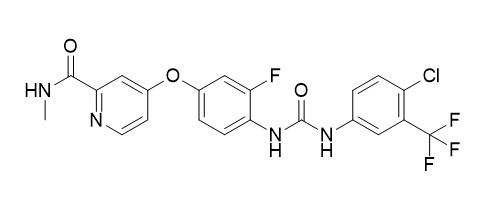Regorafenib (BAY 73-4506)
Regorafenib (BAY 73-4506, Fluoro-Sorafenib) is a multi-target inhibitor for VEGFR1, VEGFR2, VEGFR3, PDGFRβ, Kit, RET and Raf-1 with IC50 of 13 nM/4.2 nM/46 nM, 22 nM, 7 nM, 1.5 nM and 2.5 nM in cell-free assays, respectively. Regorafenib induces autophagy.
Inquire / Order:
manager@chemfaces.com
Technical Inquiries:
service@chemfaces.com
Tel:
+86-27-84237783
Fax:
+86-27-84254680
Address:
1 Building, No. 83, CheCheng Rd., Wuhan Economic and Technological Development Zone, Wuhan, Hubei 430056, PRC
Providing storage is as stated on the product vial and the vial is kept tightly sealed, the product can be stored for up to
24 months(2-8C).
Wherever possible, you should prepare and use solutions on the same day. However, if you need to make up stock solutions in advance, we recommend that you store the solution as aliquots in tightly sealed vials at -20C. Generally, these will be useable for up to two weeks. Before use, and prior to opening the vial we recommend that you allow your product to equilibrate to room temperature for at least 1 hour.
Need more advice on solubility, usage and handling? Please email to: service@chemfaces.com
The packaging of the product may have turned upside down during transportation, resulting in the natural compounds adhering to the neck or cap of the vial. take the vial out of its packaging and gently shake to let the compounds fall to the bottom of the vial. for liquid products, centrifuge at 200-500 RPM to gather the liquid at the bottom of the vial. try to avoid loss or contamination during handling.
Environ Toxicol.2024, tox.24246
Int. J. of Pha. and Phy. Res.2015, 7(1):144-149
bioRxiv2021, 462065.
Front Pharmacol.2021, 12:607403.
Plant Science2024, 338:111914
Saf Health Work.2019, 10(2):196-204
Proc Natl Acad Sci USA.2016, 113(30):E4407-1
Indian J Pharm Sci.2024, 86(2):736-741.
Preprints2017, 2017120176
Daru.2022, 30(2):273-288.
Related and Featured Products
Ther Adv Med Oncol,2010 Jan;2(1):39-49.
Targeted therapy for metastatic renal cell carcinoma: current treatment and future directions.[Pubmed:
21789125]
METHODS AND RESULTS:
An understanding of vascular endothelial growth factor (VEGF) and mammalian target of rapamycin (mTOR) pathways has greatly changed the way metastatic renal cell carcinoma (RCC) is treated.
Based on available phase III randomized trials, anti-VEGF agents such as sunitinib, sorafenib, bevacizumab-based therapy, and mTOR-targeted agents such as temsirolimus and everolimus have been used in the treatment armamentarium for this disease. Now that agents directed against these pathways have largely replaced immunotherapy as the standard of care, new questions have emerged and are the subject of ongoing clinical trials. The development of new targeted therapies including axitinib, pazopanib, cediranib, volociximab, tivozanib (AV-951), BAY 73-4506, and c-met inhibitors such as GSK1363089 and ARQ197 may potentially expand the list of treatment options.
CONCLUSIONS:
Sequential and combination targeted therapies are currently under investigation in advanced disease as are adjuvant and neo-adjuvant approaches around nephrectomy.
J Cell Physiol,2013 Feb;228(2):292-7.
Fluoro-Sorafenib (Regorafenib) effects on hepatoma cells: growth inhibition, quiescence, and recovery.[Pubmed:
22777740]
METHODS AND RESULTS:
To evaluate the growth-inhibitory properties of the potent multi-kinase antagonist Regorafenib (Fluoro-Sorafenib), which was synthesized as a more potent Sorafenib, a Raf inhibitor and to determine whether similar mechanisms were involved, human hepatoma cell lines were grown in the presence or absence of Regorafanib and examined for growth inhibition. Western blots were performed for Raf targets, apoptosis, and autophagy. Regorafenib inhibited growth of human Hep3B, PLC/PRF/5, and HepG2 cells in a concentration- and time-dependent manner. Multiple signaling pathways were altered, including MAP kinases phospho-ERK and phospho-JNK and its target phospho-c-Jun. There was evidence for apoptosis by FACS, cleavage of caspases and increased Bax levels; as well as induction of autophagy, as judged by increased Beclin-1 and LC3 (II) levels. Prolonged drug exposure resulted in cell quiescence. Full growth recovery occurred after drug removal, unlike with doxorubicin chemotherapy.
CONCLUSIONS:
Regorafenib is a potent inhibitor of cell growth. Cells surviving Regorafenib treatment remain viable, but quiescent and capable of regrowth following drug removal. The reversibility of tumor cell growth suppression after drug removal may have clinical implications.
Int J Cancer,2011 Jul 1;129(1):245-55.
Regorafenib (BAY 73-4506): a new oral multikinase inhibitor of angiogenic, stromal and oncogenic receptor tyrosine kinases with potent preclinical antitumor activity.[Pubmed:
21170960]
Cell lines: GIST 882 and TT cells
Concentrations: 5 nM-10 μM
Incubation Time: 96 hours
Method:
For proliferation assays, GIST 882 and TT cells are grown in RPMI medium containing L-glutamine, and MDA-MB-231, HepG2 and A375 cells in DMEM always containing 10% hiFBS. Cells are trypsinized, plated at 5×104 cells/well in 96-well plates in complete media containing 10% FBS and grown overnight at 37 °C. The next day, vehicle or Regorafenib serially diluted in complete growth media to between 10 μM and 5 nM final concentrations, and 0.2% DMSO, is added and incubation is continued for 96 hours. Cell proliferation is quantified.



